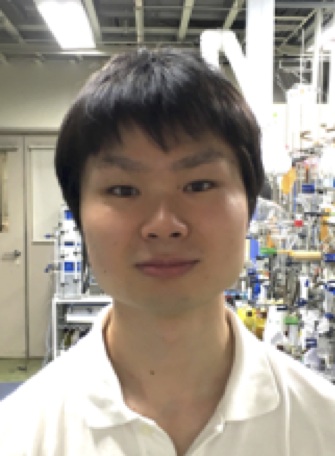Org. Synth. 2016, 93, 352-366
DOI: 10.15227/orgsyn.093.0352
Preparation of 1,1-Difluoroallenes by Difluorovinylidenation of Carbonyl Compounds
Submitted by Kohei Fuchibe, Masashi Abe, Ken Oh, and Junji Ichikawa
*1
Checked by Shogo Sato, Keiichiro Sakata, and Keisuke Suzuki
1. Procedure
A. 1,1-Difluoro-2-iodo-5-phenylpent-1-en-3-yl acetate (1). A flame-dried, 500-mL, three-necked, round-bottomed flask (Figure 1, a) is equipped with a Teflon-coated magnetic stirring bar (b), an internal thermometer (c), a dropping funnel (100 mL, d), and a three-way stopcock (e) fitted with an argon inlet. The probe of the thermometer is inserted to the round-bottomed flask through a septum (f1). A septum (f2) is placed on the dropping funnel.
The flask is charged with
diisopropylamine (16.4 mL, 11.8 g, 117 mmol, 2.24 equiv) (
Note 1) and
THF (80 mL) (
Note 2) via the dropping funnel, and the reaction mixture is chilled to 0 °C (bath temperature).
Butyllithium (71.3 mL, 1.64 M in
hexane, 117 mmol, 2.24 equiv) (
Note 3) is added to the
THF solution of
diisopropylamine over 40 min via the dropping funnel at 0 °C. The inside of the dropping funnel is rinsed with
THF (5 mL). The reaction mixture is stirred at 0 °C for an additional 10 min, and then chilled (internal temperature: -93 °C; bath temperature: -95 °C) using an ethanol/liq. N
2 bath (
Note 4).
1,1,1-Trifluoro-2-iodoethane (5.66 mL, 12.1 g, 57.4 mmol, 1.1 equiv) (
Note 5) is added to the
THF solution of
LDA over 15 min by a syringe through the septum (f1), during which the internal temperature is kept below -90 °C. The reaction mixture is stirred for 30 min. A
THF (20 mL) solution of
3-phenylpropanal (6.87 mL, 7.00 g, 52.2 mmol) (
Note 6) is added over 15 min via the dropping funnel. The inside of the dropping funnel is rinsed with
THF (5 mL). After the addition of the aldehyde, the reaction temperature is raised (internal temperature: -60 to -50 °C; bath temperature: -50 °C) over 20 min, followed by an additional 15 min stirring. When complete consumption of the aldehyde is confirmed by TLC analysis (
Note 7),
acetic anhydride (7.54 mL, 8.14 g, 79.8 mmol, 1.53 equiv) (
Note 8) is added by a syringe through the septum (f1) over 20 min, keeping the internal temperature below -50 °C. After the addition is finished, the ethanol/liq. N
2 bath is changed to an ice bath and the reaction mixture is stirred for an additional 15 min. A spot-to-spot formation of acetate (
1) is confirmed by TLC analysis (
Note 9). A saturated aq.
NH4Cl (350 mL) is added over 1 min at 0 °C (bath temperature). The products are extracted with ethyl acetate (3 × 20 mL) using a 500-mL separatory funnel. The combined organic layers are washed with brine (50 mL) and dried over anhydrous
Na2SO4 (ca. 90 g). After removal of
Na2SO4 by paper filtration, the solvent is removed by rotary evaporation (30 °C, 110 mmHg). The residue is kept under reduced pressure (room temp, 3 mmHg) to remove the solvent completely. A crude acetate (
1) is obtained as a dark brown oil (approx. 20.9 g) in 91% purity (
Note 10) and used for the next step without purification. Column chromatography (
Note 11) is used when material of higher purity is required (
Note 12).
Figure 1. Set-up for Steps A and B (a: round-bottomed flask, 500 mL; b: magnetic stirring bar; c: thermometer; d: dropping funnel; e: three-way stopcock; f1-3: rubber septum; g: adaptor; h: magnetic stirrer)
|
|
Figure 2. After addition of CF3CH2I |
Figure 3. After addition of Ac2O |
Figure 4. Crude acetate (1)
B. 1,1-Difluoro-5-phenylpenta-1,2-diene (2). Zinc dust is activated by the following procedure. A 200-mL Erlenmeyer flask is charged with zinc dust (50 g) under air (Note 13). The zinc dust is washed with 2 M aq. HCl at room temperature (3 × 80 mL) (Note 14). The zinc dust is then washed with deionized water (8 × 60 mL) (Note 15) until the pH value of the water becomes 7 (Note 16). The zinc dust is further washed with methanol (8 × 60 mL) (Note 17) and ether (8 × 60 mL) (Note 18). The obtained active zinc dust is dried under reduced pressure (room temp, 6 mmHg) and stored under argon.
A flame-dried, 500-mL, three-necked, round-bottomed flask (Figure 1, a) is equipped with a Teflon-coated magnetic stirring bar (b), an internal thermometer (c), a dropping funnel (100 mL, d), and a three-way stopcock (e) fitted with an argon inlet. The probe of the thermometer is inserted to the round-bottomed flask through a septum (f1). A septum (f2) is placed on the dropping funnel.
The flask is charged with zinc dust (6.84 g, 105 mmol, 2.2 equiv) (Note 19). Dimethylformamide (DMF) (153 mL) (Note 20) is added via the dropping funnel and the suspension is chilled to -20 °C (bath temperature). A DMF (26 mL) solution of the crude acetate (1, 20.9 g) is added over 10 min via the dropping funnel. The inside of the dropping funnel is rinsed with DMF (5 mL). The reaction mixture is warmed to room temperature and stirred for 70 min (Note 21). A spot-to-spot formation of 1,1-difluoroallene (2) (Note 22) is confirmed by TLC analysis. Unreacted zinc dust is removed by passing through a small pad of celite (7 cm × 1 cm) (Note 23) and the celite is washed with ether (50 mL). Saturated aq. NH4Cl (50 mL) and water (20 mL) are added and the products are extracted with ether (3 × 20 mL) using a 500-mL separatory funnel. The combined organic layers are washed with brine (50 mL) and dried over anhydrous Na2SO4 (ca. 30 g). After removal of Na2SO4 by paper filtration, the solvent is removed by rotary evaporation (30 °C, 260 mmHg).
The residue (14.0 g) is charged on a column (5 cm × 30 cm) of silica gel (100 g), and eluted with
pentane (60 mL fractions collected in test tubes) (
Note 24). Product (
2) is obtained in fractions 4-9. These fractions are combined and the solvent is removed by rotary evaporation (30 °C, 290 mmHg) (
Note 25). The obtained oil is kept under reduced pressure for a short period of time (room temp, 3 mmHg, 3 min) to remove the solvent completely. 1,1-Difluoroallene (
2) is obtained as a colorless oil (6.18 g, 72% yield based on crude acetate (
1) and 66% yield based on 3-phenypropanal) (Notes
26,
27 and
28).
|
|
Figure 5. After addition of crude acetate |
Figure 6. Product (2) |
2. Notes
1.
Diisopropylamine (99.0+%) was purchased from Tokyo Chemical Industry Co., Ltd. and was used after distillation from NaOH.
2.
THF (anhydrous; Kanto Chemical Co., Inc.) was purified under
argon using a solvent purification unit (Wako Pure Chemical Co., Inc.)
3.
Butyllithium (
hexane solution, 1.6 M) was purchased from Nakalai Tesque, Inc. and titrated with
diphenylacetic acid in
THF at room temperature.
4. During the preparation of CF
2=C(I)Li and the addition of aldehyde, the internal temperature must be kept below -90 °C to prevent the decomposition of the
vinyllithium through elimination of
LiF.
5.
1,1,1-Trifluoro-2-iodoethane (95+%) was purchased from Kanto Chemical Co., Inc. and used after distillation from
CaH2.
6.
3-Phenylpropanal (90+%) was purchased from Kanto Chemical Co., Inc. and used after distillation from
CaSO4.
7. TLC analysis is performed on silica gel with 20:1 hexane-AcOEt eluent (1 cm × 5 cm, glass-backed, Merck KGaA, TLC silica gel 60 F
254, 1.05715.0001).
3-Phenylpropanal has Rf = 0.31 and
1,1-difluoro-2-iodo-5-phenylpent-1-en-3-ol has Rf = 0.19.
8.
Acetic anhydride (97+%) was purchased from Kanto Chemical Co., Inc. and used after distillation from
N,
N-diethylaniline.
9. TLC analysis is performed on silica gel with 20:1 hexane-AcOEt eluent.
1,1-Difluoro-2-iodo-5-phenylpent-1-en-3-yl acetate (
1) has R
f = 0.41.
10.
19F NMR analysis
pdf of an aliquot (55.0 mg) of the crude acetate (
1, 20.9 g)
pdf using
α,α,α-trifluorotoluene (19.6 mg) as internal reference indicates that acetate (
1) is obtained in 91% yield.
α,α,α-Trifluorotoluene (98+%) was purchased from Tokyo Chemical Industry Co., Ltd.
11. If necessary, acetate (
1) can be purified by column chromatography. For example, the crude acetate (
1, 21.0 g) obtained in another run from
3-phenylpropanal (6.87 mL, 7.00 g, 52.2 mmol) is dissolved in 20:1 hexane-AcOEt (ca. 30 mL) and charged on a column (5 cm × 45 cm) of silica gel (120 g) and eluted with 20:1 hexane-AcOEt (60 mL fractions collected in test tubes). Acetate (
1) is obtained in fractions 3-15. These fractions are combined and the solvent is removed by evaporation (40 °C, 40 mmHg; RT, 4 mmHg), which affords pure acetate (
1) as a colorless oil (15.74 g, 82% yield) in 97.1% purity (
Note 10).
12.
1,1-Difluoro-2-iodo-5-phenylpent-1-en-3-yl acetate (
1) is bench-stable but should be stocked in a refrigerator (0 °C). The purified compound has the following spectroscopic properties:
1H NMR
pdf(600 MHz, CDCl
3, SiMe
4) δ: 1.86-1.92 (m, 1H), 2.05-2.11 (m, 1H), 2.07 (s, 3H), 2.56-2.61 (m, 2H), 4.96-4.99 (m, 1H), 7.17-7.22 (m, 3H), 7.29 (dd,
J = 7.4, 7.6 Hz, 2H);
13C NMR
pdf(151 MHz, CDCl
3, SiMe
4) δ: 20.9, 31.0, 36.1, 53.9 (dd,
J = 25, 26 Hz), 68.9 (d,
J = 3 Hz), 126.3, 128.3, 128.6, 140.3, 154.1 (dd,
J = 286, 286 Hz), 169.6;
19F NMR
pdf(565 MHz, CDCl
3, C
6F
6) δ: 89.2 (d,
J = 22 Hz, 1F), 90.2 (d,
J = 22 Hz, 1F); IR (ATR): 3028, 2934, 1747, 1717, 1269, 1225, 1027, 699 cm
-1; HRMS (ESI-TOF): [M+Na]
+ calcd. for C
13H
13F
2IO
2Na: 388.9826, found: 388.9821.
13.
Zinc dust (96+%) was purchased from Tokyo Chemical Industry Co., Ltd.
14. In the first wash,
zinc dust is stirred for 15 min in 2 M aq.
HCl and the aq.
HCl is then removed by decantation. In the second and third washes,
zinc dust is stirred for 30 sec. Conc.
HCl was purchased from Kishida Chemical Co., Ltd.
15.
Zinc dust is stirred for 30 sec in deionized
water and the
water is then removed by decantation.
16. The test paper was purchased from Advantec Toyo Kaisha, Ltd. (UNIV, pH 1-11).
17.
Zinc dust is stirred for 30 sec in
methanol.
Methanol (99%) was purchased from Nakalai Tesque, Inc. and used as received.
18.
Zinc dust is stirred for 30 sec in diethyl ether. Diethyl ether (anhydrous; Kanto Chemical Co., Inc.) was purified under
argon using a solvent purification unit (Wako Pure Chemical Co., Inc.)
19. Active
zinc dust is weighed under air and quickly put into the reaction vessel.
20.
DMF (99%) was purchased from Nakalai Tesque, Inc. and used after distillation from
CaH2.
21. After removing the cold bath, the internal temperature slowly rises to about 26 °C and then declines to room temperature.
22. TLC analysis is performed on silica gel with 20:1 hexane-AcOEt eluent.
1,1-Difluoro-5-phenylpenta-1,2-diene (
2) has R
f = 0.97.
23. Celite was purchased from Wako Pure Chemical Industries Ltd. (No. 500).
24.
Pentane was purchased from Nacalai Tesque, Inc. and used as received.
25. Removal of the solvent by rotary evaporation should be stopped when condensation of the solvent is not observed. Otherwise, yield of the product (
2) decreases by evaporation.
26. The reaction was checked two additional times on identical scale and provided 5.95 g (63%) and 6.20 g (66%) of the product with the yield based on 3-phenypropanal.
27. Isolated difluoroallene (
2) was analyzed by
1H NMR spectroscopy as 98.9 wt% using ethylene carbonate as an internal standard. The submitters report that difluoroallene was observed as a single peak by GC analysis (GC-14B instrument, Shimadzu Corporation), but this analysis was not attempted by the Checkers. The submitter's GC instrument was equipped with Rtx-5 (Restek Corporation) column (30 m × 0.25 mm, film thickness 0.25 μm). Retention time (
2):
t = 7.40 min with N
2 flow rate of 1.9 mL/min. Temperature profile: T = 60 °C/2 min, 60-280 °C/11 min, then 280 °C/30 min.
28.
1,1-Difluoro-5-phenylpenta-1,2-diene (
2) undergoes slow decomposition at room temperature, which therefore should be stored in a refrigerator (-19 °C). This compound has the following spectroscopic properties:
1H NMR
pdf(600 MHz, CDCl
3, SiMe
4) δ: 2.54-2.60 (m, 2H), 2.81 (t,
J = 7.6 Hz, 2H), 6.47 (tt,
J = 6.1,
2.4 Hz, 1H), 7.18-7.22 (m, 3H), 7.30 (dd,
J = 7.3, 7.3 Hz, 2H);
13C NMR
pdf(151 MHz, CDCl
3, SiMe
4) δ: 33.85, 33.86, 121.5 (t,
J = 5.5 Hz), 126.3, 128.4, 128.5, 140.7, 152.9 (t,
J = 259.2 Hz), 170.2 (t,
J = 36.0 Hz);
19F NMR
pdf(565 MHz, CDCl
3, C
6F
6) δ: 60.027 (s), 60.035 (s); IR (ATR): 3029, 2930, 2861, 2014, 1463, 1197, 747, 699 cm
-1.
Working with Hazardous Chemicals
The procedures in
Organic Syntheses are intended for use only by persons with proper training in experimental organic chemistry. All hazardous materials should be handled using the standard procedures for work with chemicals described in references such as "Prudent Practices in the Laboratory" (The National Academies Press, Washington, D.C., 2011; the full text can be accessed free of charge at
http://www.nap.edu/catalog.php?record_id=12654). All chemical waste should be disposed of in accordance with local regulations. For general guidelines for the management of chemical waste, see Chapter 8 of Prudent Practices.
In some articles in Organic Syntheses, chemical-specific hazards are highlighted in red "Caution Notes" within a procedure. It is important to recognize that the absence of a caution note does not imply that no significant hazards are associated with the chemicals involved in that procedure. Prior to performing a reaction, a thorough risk assessment should be carried out that includes a review of the potential hazards associated with each chemical and experimental operation on the scale that is planned for the procedure. Guidelines for carrying out a risk assessment and for analyzing the hazards associated with chemicals can be found in Chapter 4 of Prudent Practices.
The procedures described in Organic Syntheses are provided as published and are conducted at one's own risk. Organic Syntheses, Inc., its Editors, and its Board of Directors do not warrant or guarantee the safety of individuals using these procedures and hereby disclaim any liability for any injuries or damages claimed to have resulted from or related in any way to the procedures herein.
3. Discussion
1,1-Difluoroallenes have been synthesized via either the formation of the second C-C double bond in fluorinated alkenes or the rearrangement of the C-C triple bonds in fluorinated alkynes.
2 The former involves elimination reactions of (i) trifluoromethylalkenes and (ii) difluoroalkenes, while the latter involves substitution reactions of difluoropropargyl bromides. The substitution reactions are further classified into two types, wherein the propargyl moieties serve as (iii) nucleophiles or (iv) electrophiles.
Table 1. Synthesis of 1,1-Difluoroallenes
The present 1,1-difluoroallene synthesis is classified as the type (ii) synthesis and provides a highly general route to the variously substituted 1,1-difluoroallenes because of the wide availability of starting aldehydes and ketones (Table 1).
3 Not only linear aldehydes (Entries 1-3) but also branched aldehydes (Entries 4 and 5), including tertiary alkanals (Entry 6), afford the corresponding 1,1-difluoroallenes in high yields. Ketones are also efficiently converted to the corresponding 1,1-difluoroallenes (Entry 7). It is noteworthy that both ester and pyridine moieties are tolerant to the reaction conditions and the corresponding difluoroallenes are obtained in high yields (Scheme 1).
Scheme 1. Synthesis of 1,1-Difluoroallenes Bearing Ester and Pyridine Moieties
This difluoroallene synthesis is a modification of our former 1,1-dibromo-2,2-difluoroethene-based protocol (Scheme 2).
4 Since there is a short supply of dibromodifluoroethene because of its ozone depletion property, trifluoroiodoethane is adopted instead as a starting material.
Scheme 2. Dibromodifluoroethene-Based Synthesis of 1,1-Difluoroallenes
1,1-Difluoroallenes are versatile intermediates that undergo nucleophilic additions, substitutions, and cycloadditions.
1 In addition, difluoroallenes serve as an appropriate platform for the synthesis of polycyclic aromatic hydrocarbons (PAHs).
5 1,1-Difluoroallenes, bearing an aryl group and an alkyl substituent adjacent to the difluoroallene moiety, are readily prepared from arylacetonitriles by half-reduction followed by difluorovinylidenation (Scheme 3). Treatment of the 1,1-difluoroallenes with 2 mol% of InBr
3 facilitates the domino Friedel-Crafts-type cyclization/1,2-alkyl migration (or deprotonation) to afford regioselectively fluorinated naphthalenes in high yields. Difluoroallenes bearing an aryl group and a cyclopentene moiety similarly undergo the domino Friedel-Crafts-type cyclization/alkyl migration sequence, resulting in ring formation and ring expansion. Subsequent one-pot dehydrogenation with 2,3-dichloro-5,6-dicyano-
p-benzoquinone (DDQ) efficiently provides pinpoint-fluorinated higher-order PAHs (Scheme 4), which are promising organic materials for printable electronic devices.
6
Scheme 3. Domino Synthesis of Pinpoint-Fluorinated Naphthalenes
Scheme 4. Domino Synthesis of Pinpoint-Fluorinated PAHs
Appendix
Chemical Abstracts Nomenclature (Registry Number)
1,1-Difluoro-2-iodo-5-phenylpent-1-en-3-yl acetate: Benzenepropanol, α-(2,2-difluoro-1-iodoethenyl)-, 1-acetate; (1) (1309570-95-3)
Diisopropylamine: 2-Propanamine, N-(1-methylethyl)-; (108-18-9)
Butyllithium: Lithium, butyl-; (109-72-8)
1,1,1-Trifluoro-2-iodoethane: Ethane, 1,1,1-trifluoro-2-iodo-; (353-83-3)
3-Phenylpropanal: Benzenepropanal; (104-53-0)
Acetic anhydride: Acetic acid, 1,1'-anhydride; (108-24-7)
1,1-Difluoro-5-phenylpenta-1,2-diene: Benzene, (5,5-difluoro-3,4-pentadien-1-yl)-; (2) (1186222-29-6)
Zinc; (7440-66-6)

|
Kohei Fuchibe was born in Fukui, Japan in 1974. He received his B.Sc. in 1999 and Ph.D. in 2002 from the University of Tokyo (Prof. K. Narasaka). He joined Gakushuin University as a Research Associate in 2002 and was shifted to an Assistant Professor in 2007. He moved to University of Tsukuba as a Lecturer in 2007 and was promoted to an Associate Professor in 2011. His research interests involve organic synthetic reactions catalyzed by transition metals or organic small molecules. |

|
Masashi Abe was born in the state of New Hampshire, USA in 1991. He received his B.Sc. in 2014 from University of Tsukuba and is pursuing a master's degree at the same university (Prof. J. Ichikawa). He is majoring in synthetic organic chemistry and now working on the development of synthetic methods for polycyclic aromatic hydrocarbons. |

|
Ken Oh (Jian Wang) was born in Shandong, China in 1970, graduated from Wuhan University in 1991, moved to Japan as a research student in 1998, received his M.Sc. in 2001 from the University of Tokyo (Prof. K. Kitazawa) and Ph.D. in 2012 from University of Tsukuba (Prof. J. Ichikawa). He joined Shandong Non-metallic Materials Institute in 1991. He worked as a Senior Chemist for DuPont-Mitsui Fluorochemicals Co., Ltd. during 2005-2012. From 2012, he worked as a Chief Senior Researcher in Zeon Corporation. His research interests involve organic synthesis of functional molecules (from small to macro), especially organofluorine compounds. |

|
Junji Ichikawa was born in Tokyo, Japan in 1958. He received his B.Sc. in 1981 and Ph.D. in 1986 from the University of Tokyo (Prof. T. Mukaiyama). He joined Kyushu University as an Assistant Professor in 1985. In 1989, he was a postdoctoral research associate in Harvard University (Prof. E. J. Corey) and then worked in Kyushu Institute of Technology as a Lecturer and an Associate Professor. In 1999, he moved to the University of Tokyo, as an Associate Professor. He was appointed Professor in University of Tsukuba in 2007. His research interests lie in the area of synthetic methodology based on the properties of metals and fluorine. |

|
Shogo Sato was born in Kanagawa, Japan in 1990. He received his B.Sc. degree from Aoyama Gakuin University (Prof. H. Sugimura) in 2013. In the same year, he joined the research group of Prof. Keisuke Suzuki at Tokyo Institute of Technology. His research focuses on the synthesis of natural products. |

|
Keiichiro Sakata was born in Tokyo, Japan in 1992. He received his B.S. degree in 2015 from Waseda University (Prof. S. Hosokawa) and pursing a master's degree at Tokyo Institute of Technology (Prof. K. Suzuki). He is majoring in synthetic organic chemistry and now focuses on synthetic methods of natural products. |
Copyright © 1921-, Organic Syntheses, Inc. All Rights Reserved